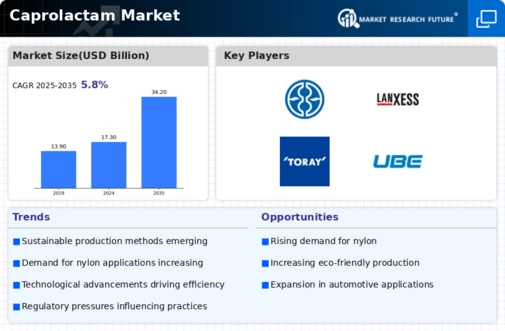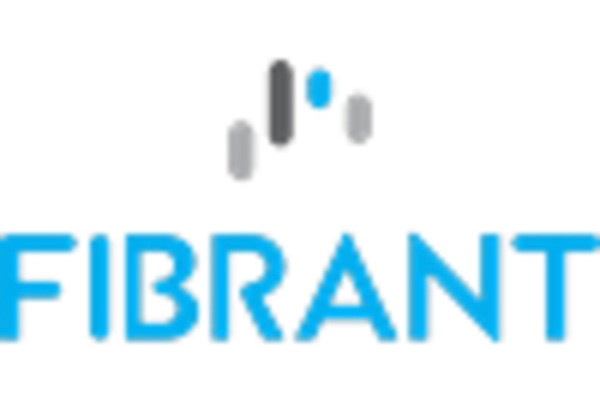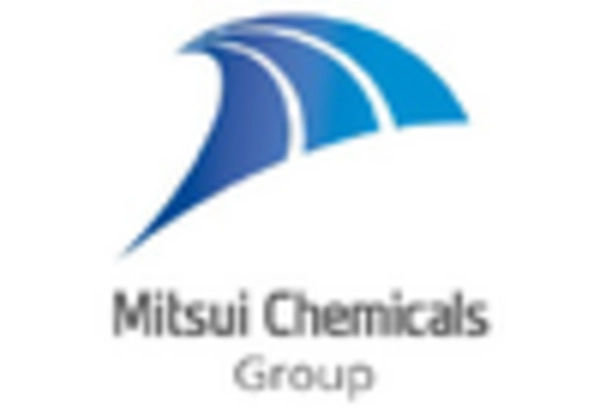Rising Demand for Nylon 6
The Caprolactam Market is experiencing a notable increase in demand for Nylon 6, a polymer derived from caprolactam. This surge is primarily driven by the expanding automotive and textile sectors, where Nylon 6 is favored for its strength, durability, and lightweight properties. In 2023, the demand for Nylon 6 was projected to reach approximately 5 million tons, indicating a robust growth trajectory. As industries seek materials that enhance performance while reducing weight, the Caprolactam Market is poised to benefit significantly. Furthermore, the increasing adoption of Nylon 6 in various applications, including industrial fibers and consumer goods, suggests a sustained demand that could bolster caprolactam production and consumption in the coming years.
Growth in Automotive Sector
The Caprolactam Market is likely to witness substantial growth due to the automotive sector's expansion. As manufacturers increasingly utilize caprolactam-derived materials for components such as fuel lines, airbags, and interior trims, the demand for caprolactam is expected to rise. In 2023, the automotive industry accounted for nearly 30% of the total caprolactam consumption, reflecting its critical role in driving market dynamics. The trend towards lightweight materials in vehicles, aimed at improving fuel efficiency and reducing emissions, further underscores the importance of caprolactam in this sector. As the automotive industry continues to evolve, the Caprolactam Market may experience a corresponding increase in demand, potentially leading to innovations in production processes and applications.
Diversification of End-Use Applications
The Caprolactam Market is witnessing a diversification of end-use applications, which is contributing to its growth. Beyond traditional uses in textiles and automotive, caprolactam is increasingly being utilized in sectors such as electronics, packaging, and consumer goods. This expansion into new markets is driven by the material's favorable properties, including chemical resistance and thermal stability. In 2023, the electronics sector accounted for approximately 15% of caprolactam consumption, highlighting its emerging role in this industry. As manufacturers seek versatile materials that meet diverse application requirements, the Caprolactam Market is likely to see sustained demand across various sectors, fostering innovation and development in product offerings.
Technological Innovations in Production
Technological advancements are playing a pivotal role in shaping the Caprolactam Market. Innovations in production processes, such as the development of more efficient catalytic methods and the integration of automation, are enhancing the overall efficiency and cost-effectiveness of caprolactam manufacturing. In recent years, several companies have reported a reduction in production costs by up to 15% due to these technological improvements. Furthermore, advancements in recycling technologies are enabling the recovery of caprolactam from waste materials, thereby promoting a circular economy. As these technologies continue to evolve, the Caprolactam Market is likely to benefit from increased production capacities and reduced environmental impact, positioning it favorably for future growth.
Increasing Focus on Sustainable Practices
Sustainability initiatives are becoming increasingly prominent within the Caprolactam Market. As environmental concerns grow, manufacturers are exploring eco-friendly production methods and alternative feedstocks for caprolactam synthesis. The shift towards sustainable practices is not only driven by regulatory pressures but also by consumer preferences for environmentally responsible products. In 2023, approximately 20% of caprolactam producers reported investments in sustainable technologies, indicating a significant trend towards greener production. This focus on sustainability could enhance the market's appeal, attracting new customers and fostering partnerships with companies committed to reducing their carbon footprint. As the Caprolactam Market adapts to these changes, it may unlock new opportunities for growth and innovation.


















Leave a Comment